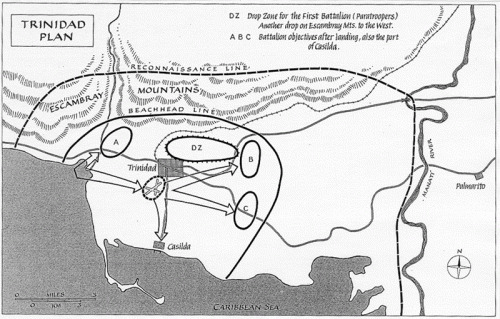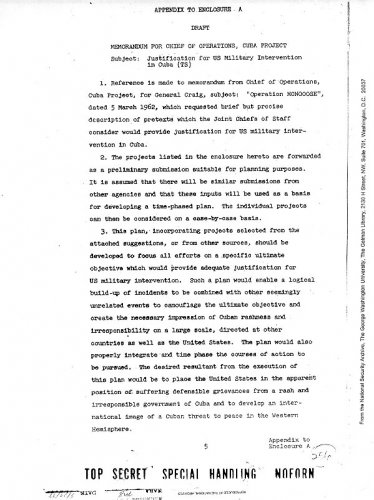- Joined
- 29 July 2009
- Messages
- 1,519
- Reaction score
- 1,521
The original Cuban invasion plan, authorized by President John F. Kennedy on January 28, 1961, was code named Operation Pluto. The plan was to land approximately 1,500 Cuban exiles on the coast of Trinidad, Cuba, between the Escambray Mountains and the southern coast of Cuba. The plan was considered a favorable one as there were only three roads into Trinidad (approximately 80 miles from the swampy Bay of Pigs, and nearer Guantanamo Naval Base), the landing beaches in Trinidad easier to access, the Escambray Mountains provided a better means of escape, and the people in this region were not ardent followers of Fidel Castro.
Operation Pluto was later rejected by Kennedy as "too noisy" leading to the final plan, Operation Zapata, accepted on April 4, 1961, because the landings wouldn't be conducted in a populated area and it was nearer an airbase in which the exiles could capture and begin launching their own aircraft.
As the operation unfolded at the Bay of Pigs, the exile's B-26 attack force was cut from 18 aircraft to 6 and there was no assistance to the exiles from the American Naval Task Force 81.8 parked off the coast of southern Cuba, which provided them escort into Cuban waters. At the center of the task force was the the USS Essex, with its AD-1 Skyraiders and A-4 Skyhawks, which conducted reconnaissance flights with aircraft devoid of US Navy markings. The Essex's aircraft at no time engaged in offensive combat against the Cubans.
Alternate History: Operation Pluto
President Kennedy makes a commitment to rid the western hemisphere of Soviet influence and has Richard Bissell, DD of Plans at the CIA, draw up details for a clandestine assault using US military personnel and assets to initiate the attack, beginning with assaults against air bases and army garrisons during the night, with the stipulation that the initial US elements in the attack only be carried out at night and with moderately sanitized aircraft. At dawn on the first morning of the assault the Cuban battalion of exiles land and are parachuted into the area around Trinidad.
Once in Trinidad that exiles seal off the roads into the city and link up with Cuban guerrillas in the Escambray Mountains and begin recruiting for a resistance movement. US Army Special Forces make there way into western Cuba and begin training and leading guerrillas against Castro's forces.
A popular political Cuban exile is cultivated and brought into the country to become a focal point as the voice of the resistance movement and its ideological center. Cuban's rally around the notion of a free and independent non-communist country, with images of the 15,000 Cuban dissident executions, tortures, and purges.
The US declares its support for a 'Free Cuba' and provides military support for the Cuban 'Freedom Fighters.' Naval operations around Cuba and US air support from captured bases weakens the command and control infrastructure creating a fracture in the 25,000 man Cuban Army, which begins to realize the strength of the US backed invasion. The 200,000 militia of men and women decide, after listening to Radio Free Cuba, that death in a communist Cuba may be less attractive than life in a democratic one, and stay at home, waiting for the fight to end.
Any thoughts on orders of battle, aircraft used on both sides, Soviet intervention, effectiveness of guerrilla movement, etc.?
Operation Pluto was later rejected by Kennedy as "too noisy" leading to the final plan, Operation Zapata, accepted on April 4, 1961, because the landings wouldn't be conducted in a populated area and it was nearer an airbase in which the exiles could capture and begin launching their own aircraft.
As the operation unfolded at the Bay of Pigs, the exile's B-26 attack force was cut from 18 aircraft to 6 and there was no assistance to the exiles from the American Naval Task Force 81.8 parked off the coast of southern Cuba, which provided them escort into Cuban waters. At the center of the task force was the the USS Essex, with its AD-1 Skyraiders and A-4 Skyhawks, which conducted reconnaissance flights with aircraft devoid of US Navy markings. The Essex's aircraft at no time engaged in offensive combat against the Cubans.
Alternate History: Operation Pluto
President Kennedy makes a commitment to rid the western hemisphere of Soviet influence and has Richard Bissell, DD of Plans at the CIA, draw up details for a clandestine assault using US military personnel and assets to initiate the attack, beginning with assaults against air bases and army garrisons during the night, with the stipulation that the initial US elements in the attack only be carried out at night and with moderately sanitized aircraft. At dawn on the first morning of the assault the Cuban battalion of exiles land and are parachuted into the area around Trinidad.
Once in Trinidad that exiles seal off the roads into the city and link up with Cuban guerrillas in the Escambray Mountains and begin recruiting for a resistance movement. US Army Special Forces make there way into western Cuba and begin training and leading guerrillas against Castro's forces.
A popular political Cuban exile is cultivated and brought into the country to become a focal point as the voice of the resistance movement and its ideological center. Cuban's rally around the notion of a free and independent non-communist country, with images of the 15,000 Cuban dissident executions, tortures, and purges.
The US declares its support for a 'Free Cuba' and provides military support for the Cuban 'Freedom Fighters.' Naval operations around Cuba and US air support from captured bases weakens the command and control infrastructure creating a fracture in the 25,000 man Cuban Army, which begins to realize the strength of the US backed invasion. The 200,000 militia of men and women decide, after listening to Radio Free Cuba, that death in a communist Cuba may be less attractive than life in a democratic one, and stay at home, waiting for the fight to end.
Any thoughts on orders of battle, aircraft used on both sides, Soviet intervention, effectiveness of guerrilla movement, etc.?


